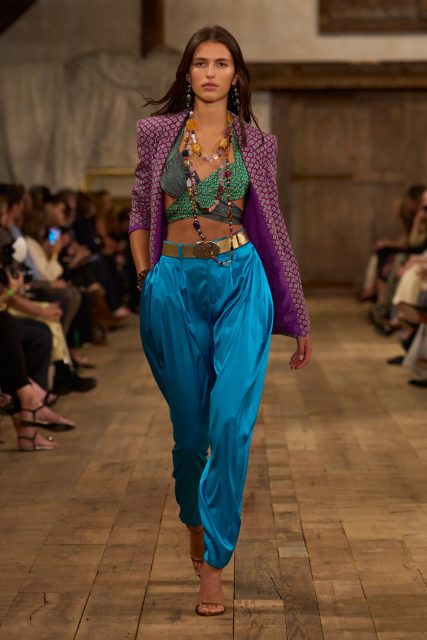This year marks Stuart Vevers’s tenth anniversary at Coach. “I was reflecting on it a little, not too much,” he said the day before during a preview at the brand’s Hudson Yards headquarters. “I wanted to capture New York archetypes—my New York archetypes—but rather than look at vintage images of that time I wanted to remember it in my own way.” He added, “It’s a very personal collection.”
In a way, New York City played the starring role here: the show took place at the main branch of the New York Public Library near Bryant Park (another iconic fashion landmark), with Vevers’s children and father present (it was the first time he’d attended a fashion show). It’s the city where the British designer met his husband and started a family; the city where he’s been hard at work cementing the legacy of Coach as “America’s House of Leather,” especially what it means to be a house of leather in 2023, when so many conversations revolve around topics of sustainability and climate change. That Vevers has made these an important part of his collections, working with upcycled leather and denim, as well as regenerated cotton and leather, made the rare appearance by an anti-leather protester all the more strange, though it’s worth noting that security did not force her off the catwalk. “I respect all points of view,” Vevers said later at the celebratory dinner.
But what about the clothes? Although Vevers was in a wistful mode, this wasn’t about bringing back the greatest hits from his early collections. Rather, it was a continuation of the shapes and experiments on construction and silhouette that he’s been developing in recent seasons. The show opened with a black slipdress made from pieced-together leather with exposed stitches, moto boots, and a cool little rounded bowling bag. “There was no archival reference for it,” he said. “It was just what I imagined a Coach bag should be—and maybe that’s a reflection of my time at Coach.” Vevers’s great fascination with oversized leather jackets continued: a single-breasted blazer, worn over a mesh turtleneck and pointy jelly flats, was a very chic proposition indeed. There were also fringed suede jackets, and upcycled denim jackets, with the let-out hems acting as a trim detail on pockets.
Coach may be a house of leather, but the big news tonight was the introduction of soft suiting made from cotton or wool that had been overused and washed, and subtly “aged” to perfection. A mossy green suit with an oversized, slouchy jacket worn with a matching slim maxi skirt—a continuation of the silhouette Vevers began exploring last season—was certainly one of the collection’s brightest propositions (literally and figuratively). Ditto a version with a chore jacket in khaki, the shoulder seams darkened from the imagined wear and tear of a bag or also just life.
“The thing that I always talk about at Coach is that I want things to feel love-worn,” Vevers said. Which in a way all the pieces were, love-worn by his own memories of being young in the city, going to dance at the Pyramid club, or being older in the city and still having a meal at a favorite restaurant that feels like it’s frozen in time. That would be Donohue’s, a steakhouse on Lexington. “It was my favorite then and it’s my favorite still and it’s full of characters and doesn’t seem to have been updated since maybe the ’60s,” he said. The logo adorned a series of T-shirts and matching short sleeve sweatshirts and sweatpants whose distinctly collegiate vibe was at humorous odds with the source material; but you know, that’s New York, too.
“This is my memory of a specific time,” Vevers said. “And there’s something quite liberating in that because once you’ve found that memory and you’ve done a sketch, you can make it however you want to bring it to life.”
Editor
Laia Garcia-FurtadoCredit
Lead Image: Isidore Montag / Gorunway.com

